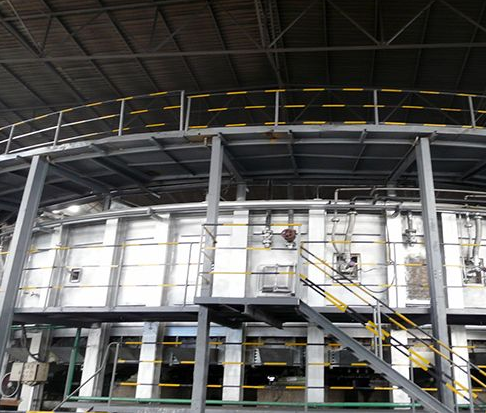Coal-based Direct Reduction Rotary Hearth Furnace Process (1)
Rotary hearth furnace technology (RHF) was developed and built in the United States in 1978 by the International Metal Company affiliated to INCO Group of Canada in order to treat and utilize metallurgical wastes. It can not only be used to treat dust produced by metallurgical plants and other wastes containing iron, chromium, and zinc, but also in reducing iron ore.

1. Process characteristics of the rotary hearth furnace
1.1 Advantages
① The reaction temperature is high and the reaction speed is fast.
② When the burden is standing on the hearth, the strength of fresh briquettes is required to be low.
③ The burner is arranged around the furnace, so as to realize the accurate control of the temperature and atmosphere in the furnace.
④ Adopt automatic control of starting and stopping which is convenient to adjust.
1.2 Limitations
The characteristics of the process determine that the content of gangue and S in DRI products is high, and the metallization rate of TFe and DRI is low.
In rotary hearth furnace process, pulverized coal is blended as a reducing agent, and binder is added to make fresh briquettes, iron ore grade or solid waste, but the influence of iron and coal on DRI is the same. Therefore, if we want to produce high-quality DRI, we need high-grade iron ore powder or solid waste with high iron content and coal with low ash and low S as a reducing agent. For DRI products with TFe and metallization rate of 90%, TFe of magnetite needs to reach 69.5%, hematite needs to reach 68.5%, but ash content of coal should be less than 4% and S should be less than 0.6%. If ordinary iron ore (grade 64%) and ordinary coal (ash 12%) are used for blast furnaces, the TFe of DRI product obtained by rotary hearth furnace is only 78%, and the metallization rate is about 85%. DRI products of rotary hearth furnace process are mostly used as blast furnace raw materials, and also as a converter and electric furnace burden, but the amount of DRI products is quite small, which has little influence on steelmaking production. Therefore, the rotary hearth furnace process is most suitable for the treatment of low-grade refractory ore dressing and iron and steel smelting dust at present.
2. Process
2.1 Rotary Hearth Furnace (RHF)
In order to reduce external discharge, rotary hearth furnace is used to treat solid waste of iron and steel enterprises, and alkali metals in solid waste are removed and recovered. As blast furnace charge or converter coolant, DRI can reduce coke ratio of blast furnace and iron consumption of the converter. The economy and technology of the process has been verified.
2.2 Rotary Hearth Furnace + Magnetic Separation or Rotary Hearth Furnace + Electric Furnace
According to the advantages of rotary hearth furnace, combined with magnetic separation or electric furnace, local researchers and abroad have developed a variety of new direct reduction processes for treating refractory ores, nickel ores, vanadium-titanium ores, and chromium ores. This kind of process is quite different from rotary kiln + magnetic separation and rotary kiln + electric furnace in essence. The rotary hearth furnace has the advantages of low raw material strength requirement and strong reduction control ability, and at the same time, it also avoids the potential risk of easy ring formation and difficult operation of rotary kiln. In the process line, it can replace the pre-reduction function of the rotary kiln, but also has further strengthened. Subsequent electric furnaces and other equipment mainly play the role of melting separation, weakening the reduction function.
Rotary Hearth Furnace + Magnetic Separation equipment is relatively simple, but the product grade and the yield are relatively low. However, a rotary hearth furnace + electric furnace has a large investment, and a desulfurization process can be added. The products are ferronickel, ferrochrome, etc., and the market recognition is also high.




